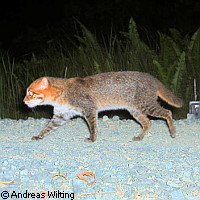Save the flat-headed cat, save the world
Animal species worldwide find refuge in the rain forests that dot the globe. But as human activities play havoc with our planet, countless creatures worldwide are feeling the effects. A case in point is the flat-headed cat (Prionailurus planiceps) which makes its home in the rain forests of Southeast Asia. New international research shows that this area has been converted into plantations, effectively making the area uninhabitable for these cats. Published in the Public Library of Science (PLoS) ONE journal, the study's findings also show that only 16% of the rain forest area is fully protected according to International Union for Conservation of Nature (IUCN) criteria. The researchers, led by the Berlin, Germany-based Leibniz Institute for Zoo and Wildlife Research (IZW), highlighted the fact that not only is just a small fraction of the area under protection, but the remaining habitats are extremely fragmented. The main problem is that the majority of large national parks in Southeast Asia, specifically in peninsular Thailand, Malaysia, Borneo and Sumatra, are located at higher elevations, and the flat-headed cat is restricted to lowland and coastal swampy forested areas. 'We gathered all available scattered information on this cat which showed us that it mainly occurs in lowland or peat-swamp forests close to freshwater sources,' explained lead author Dr Andreas Wilting from the IZW. 'With this information we developed a computer model to predict its historical and current distribution. The next step is to gain further information about the ecology of this little-known species and to enforce the protection and thus ensure the sustainability of the key remaining forest habitats,' he added. 'For this purpose we identified 19 key localities throughout the distribution range highlighted by our model as important for the long-term survival of this rare species.' On the one hand, tropical Southeast Asia is home to many different species, but on the other hand, it is also renowned for having the highest deforestation rate on our planet. Experts caution that biodiversity can be protected if habitats are watched over as well. The research team is encouraging people to protect the highly threatened lowland and wetland forests in Southeast Asia and they are using the flat-headed cat to rouse people into action. Weighing up to two kilograms, the flat-headed cat is unique in that it uses its webbed feet to hunt fish and crabs within wetland habitats such as flooded peat forests and river banks in various tropical rainforests of Peninsular Thailand, Malaysia and Indonesia, among others. Researchers from Australia, Denmark, Germany, Indonesia, Malaysia, Switzerland, the UK and the US also contributed to the study.



